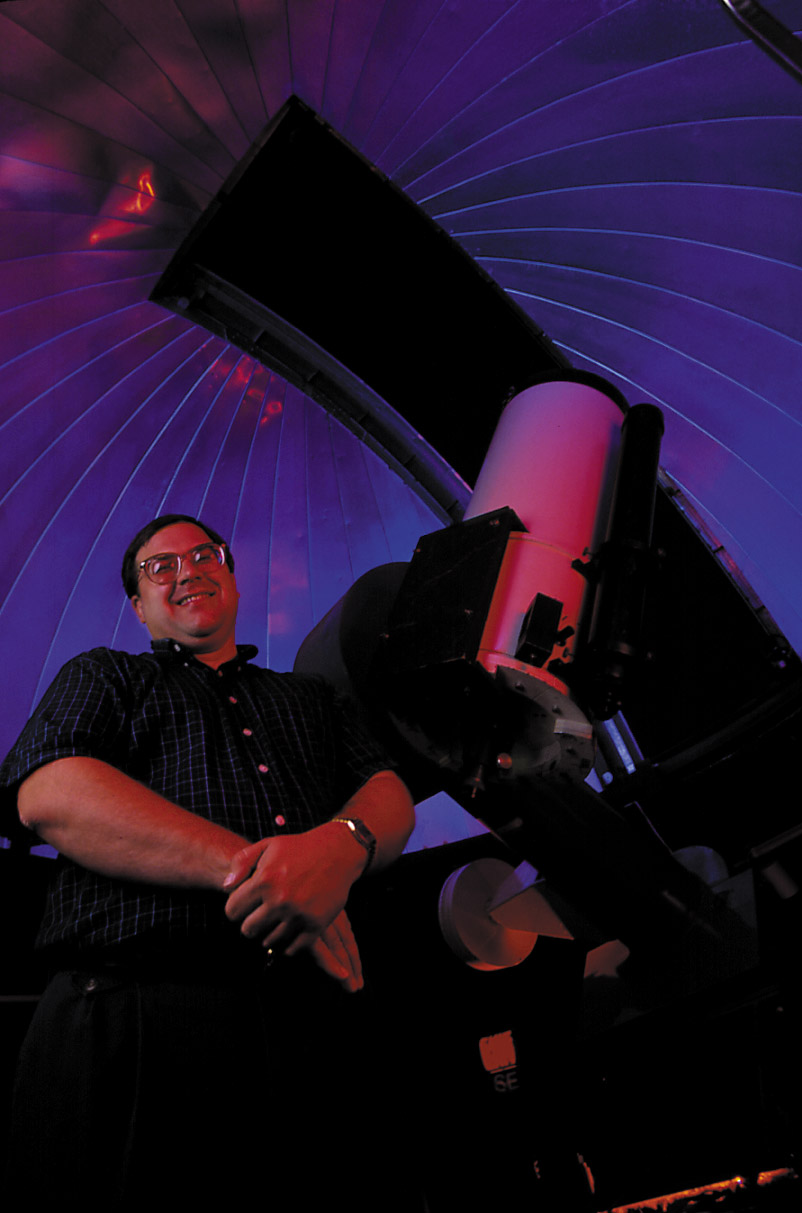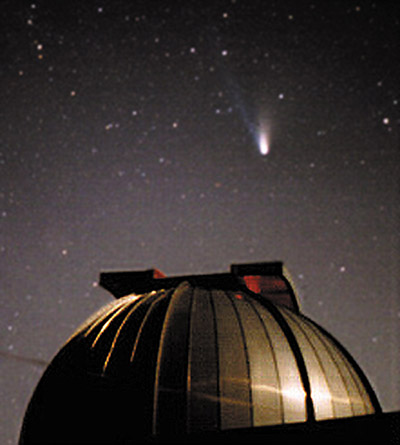 It's no secret. If you want to see stars, Kansas is definitely the place.
It's no secret. If you want to see stars, Kansas is definitely the place.
A more exact location would be the Lake Afton Public Observatory, which has the distinction of being only one of approximately a dozen observatories in the entire country designed specifically so that the average person can look into outer space. Nestled near one of the Wichita area's most popular lakes, the observatory is the public's opportunity to see far more than they usually do with the naked eye — sunspots (which are actually large enough for the earth to span a few hundred times over), comets, meteor showers, even the rings of Saturn. "The most fun I have," says Greg Novacek, director of the observatory, "is showing people things through the telescope, especially young children. They'll look at Saturn and say, 'Oh! It really does have rings!'"
The telescope Novacek refers to is the observatory's Cassegrain telescope, which enables everyone from the seasoned astronomy buff to children of four and five to see the heavens up close. The different age ranges and walks of life that visitors to the center come from best explains the observatory's philosophy. "Like the Ulrich museum and the museum of anthropology," Novacek says, "the observatory is one of the things that Wichita State offers to the community." And Novacek has the data to prove the community takes advantage of this opportunity. The observatory, open to the general public on Saturdays and Sundays, has an average of about 300 visitors each weekend, assuming something like Haley's Comet isn't making an appearance in the skies, an appearance that in the mid-eighties drew 1,000 people. Novacek grins. "There was actually a traffic jam on MacArthur, if you can envision that."
Created in 1979 by the City of Wichita, Sedgwick County, the Wichita Public Schools, and Wichita State University, the observatory's first program was offered on June 12, 1981. Wichita State's Fairmount Center for Science and Mathematics has operated the observatory since 1994 with financial assistance from Sedgwick County.
Novacek's staff includes assistant director Scott Kardell, a student assistant and a graduate assistant, and a team of about eight volunteers who, out of a pure love for astronomy, donate their time to keep the observatory running smoothly. In addition to his time spent as the observatory's director, Novacek is also director of the Fairmount Center for Science and Mathematics and the Kansas Science Olympiad.
Novacek and his staff offer many programs to the general public, each of which has a different thematic focus, such as "From the Moon to the Stars," which lends the opportunity to look at the moon's surface and the planet Uranus or Neptune, and a program coming up in November and December, "Voyage Through the Solar System." You can find the dates and times of these and other programs in the Almanac section of this magazine, or you can call the observatory at (316) WSU-star.
Those who wish to take photographs may do so on selected evenings as the observatory also offers a series of photography programs. The only requirement is a 35mm single-lens reflex camera to which the Cassegrain telescope can be adapted. The staff also offers school programs on Wednesday and Thursday evenings by appointment, and Thursdays during the day for classes that wish to observe the sun.
"The most fun I have is showing people things through the telescope, especially young children. They'll look at Saturn and say, 'Oh! It really does have rings!'"
— Greg Novacek
Aside from looking through the 16-inch telescope, there are a number of exhibits throughout the observatory, from the one that explains in about five billion years the sun will begin its process of becoming a black dwarf (or a dead star), to a meteor display in the lobby of the observatory. The fact that Kansas is a farming state helps place Kansas in a unique astronomical category: along with Texas, more meteors are found here than anywhere else in the United States.
"This is not," warns Novacek, "because Kansas is in the middle of the United States or anything like that. However, if you're a farmer, when you plow your field and you hit a rock, you're most likely to pick it up and pitch it. But if there's something different about that rock, you're going to hang onto it."
After touching one of the meteors on display and getting a sense of its slightly metallic exterior, it's easy to understand why someone would be intrigued by what at first appeared to be a mere "rock." The meteor display consists of some that have actually been found in Kansas and some that are on loan to the observatory from other parts of the United States and the world. Chile actually holds the record for the country where the most meteors have been found.
Aside from Haley's Comet, people also had the opportunity in 1996 to see the comet Hyakutake (pronounced Yacacataki). But Haley's Comet brings back one of the fondest moments for Novacek. "We had all sorts of people come in. We had children who were three and four years old and adults who were in their eighties. We had some older people come in to see the comet who had also seen it in 1910. That was pretty neat."
Of course, Mother Nature always has the final say, and cloudy days usually prevent people from seeing anything other than our own local overcast sky, but luckily the main emphasis at the observatory remains education, and there's plenty of things to do despite cloudy weather.
 Each of the exhibits has been contructed by staff members, which is a source of obvious pride for Novacek. "It's wonderful to take an idea, refine it, and see people interact with it," he says. Some of the exhibits are also portable, which enables staff members to take them to public school classrooms and leave them with teachers for a few weeks at a time.
Each of the exhibits has been contructed by staff members, which is a source of obvious pride for Novacek. "It's wonderful to take an idea, refine it, and see people interact with it," he says. Some of the exhibits are also portable, which enables staff members to take them to public school classrooms and leave them with teachers for a few weeks at a time.
While looking at the stars and planets in our solar system can be fun for people of all ages, a love of astronomy is something that usually begins at a young age. With this thought in mind, the observatory's home page has a site for both teachers and children, and this offers some helpful tidbits for instructors who want to know more about the observatory, the programs it offers, as well as other science programs in the greater Wichita area.
A trip to the observatory itself is most helpful. Even when clouds prevent people from looking through the Cassegrain telescope, they can always take advantage of the universe of information about planets and stars that's displayed throughout the observatory. There's even an exhibit that explains how the Cassegrain telescope works, along with its Newtonian and Refracting counterparts. And you don't just have to read about the astronomical instruments. There are parts and instructions which allow anyone to try a hand at assembling a telescope.
In another interactive display, computers invite visitors to match wits on astronomy trivia. How many planets are in the solar system? (And don't let that rumor about another planet in the solar system fool you.) What galaxy are we located in? Who invented the telescope? If you can't quite recall the answers, don't worry. After a humbling stroll down Amnesia Lane, Novacek and his assistants (aside from running back and forth between the telescope and the exhibit area) are always on hand to answer any questions you might have.
For Novacek, it's an all-around rewarding experience, and it should be, because he doesn't just tell people to shoot for the stars.
"I help people see the universe."





